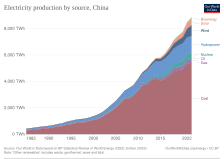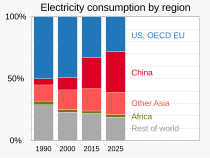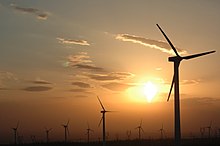Научитесь безопасно инвестировать в условиях кризиса и выгодно использовать падение рынка. Бесплатный онлайн марафон «Я — Инвестор». Принять участие.
China Yangtze Power Co. Ltd производит гидроэлектроэнергию. Деятельность компании включает производство электроэнергии, технологическое сопровождение, управление и инвестиции, капитальный ремонт и техническое обслуживание гидроэлектростанций. Компания основана 4 ноября 2002 года, штаб-квартира в Пекине, Китай.
- Рыночная капитализация: 54.4 млрд
CGN Power Co. Ltd — холдинговая компания, которая занимается производством и продажей электроэнергии, строительством, эксплуатацией и управлением ядерными и неядерными чистыми проектами. Компания участвует в неядерном энергетическом бизнесе в ветровой, гидроэнергетике, солнечной энергетике и других областях. В сфере деятельности также освоение ресурсов урана, торговля природным ураном и бизнесом, связанным с ядерным топливом, финансовые услуги, применение ядерной технологии, кроме ядерной энергетики, общие услуги, транспорт, благоустройство, водоснабжение, ремонт бытовой техники, эксплуатация и управление недвижимостью, услуги по уборке и озеленению, а также инвестиционный холдинг в других сферах бизнеса. Компания основана 25 марта 2014 года, штаб-квартира в Шэньчжэне, Китай.
- Рыночная капитализация: 12.6 млрд
China National Nuclear Power Co. Ltd занимается разработкой, эксплуатацией, строительством, инвестированием и управлением атомных электростанций. Предлагает природный уран, конверсию и обогащение урана, изготовление топливных сборок, переработку отработанного топлива и утилизацию ядерных отходов. Компания основана 21 января 2008 года, штаб-квартира в Пекине, Китай.
- Рыночная капитализация: 9.6 млрд
SDIC Power Holdings Co. Ltd занимается строительством, инвестированием и управлением энергетическими проектами. Работает через следующие подразделения: электроэнергетика и уголь. Подразделение электроэнергетики занимается строительством и развитием проектов по выработке электроэнергии. Подразделение сырого угля покупает и продает недавно добытый уголь. Компания основана 23 февраля 1989 года, штаб-квартира в Пекине, Китай.
- Рыночная капитализация: 7.4 млрд
Zhejiang Zheneng Electric Power Co. Ltd производит и поставляет электроэнергию. Компания сосредоточена на операциях, управлении электроэнергией, исследованиях и разработках в области энергетики, энергосберегающих технологиях, технических консультационных услугах, продаже энергосберегающих продуктов, энергетике, строительстве, надзоре за окружающей средой, инженерном обеспечении электроэнергетики и обслуживании энергетического оборудования. Компания основана 14 марта 1992 года, штаб-квартира в Ханчжоу, Китай.
- Рыночная капитализация: 6.7 млрд
Huaneng Power International, Inc. занимается разработкой, строительством и эксплуатацией крупных электростанций с использованием современных технологий и оборудования, а также с использованием международного и отечественного капитала. Работает в следующих сегментах: PRC Power, Сингапур и другие. Сегмент PRC Power продает генерируемую электроэнергию и тепло в Китае. Сингапурский сегмент управляет Tuas Power Ltd. Сегмент «Другие» предоставляет портовые и транспортные услуги, сервисы. Компания основана 30 июня 1994 года, штаб-квартира в Пекине, Китай.
- Рыночная капитализация: 5.9 млрд
GD Power Development Co. Ltd занимается производством, распределением и продажей электроэнергии. Также предоставляет услуги по управлению сетью электропитания и информационные консультации. Компания основана 31 декабря 1992 года, штаб-квартира в Пекине, Китай.
- Рыночная капитализация: 5.5 млрд
Huadian Power International Corp. Ltd занимается производством электроэнергии и отоплением. Деятельность компании также включает в себя продажу угля, технические услуги, связанные с электроэнергией, и информационный консалтинг. Компания основана 28 июня 1994 года, штаб-квартира в Пекине, Китай.
- Рыночная капитализация: 3.4 млрд
Datang International Power Generation Co. Ltd — международная энергетическая компания. Работает в следующих сегментах: производство электроэнергии, уголь, химическая и другие. Предоставляет такие услуги, как строительство и эксплуатация электростанций, продажа электроэнергии и пара, продажа, техническое обслуживание и ремонт оборудования для производства электроэнергии и другие услуги в области энергетических технологий. Компания основана 13 декабря 1994 года, штаб-квартира в Пекине, Китай.
- Рыночная капитализация: 2.7 млрд
Каталог компаний «Энергетики Китая — крупнейшие китайкие энергетические компании» — это перечень ведущих энергетических китайских предприятий. По каждой компании приводятся контактные данные: адрес, телефоны, интернет адрес, а также другие важные факты — год основания, количество сотрудников, объём продаж, ведущие специалисты и др.
Крупнейшие компании энергетики в Китае выстроены в рейтинг по посещаемости их корпоративных сайтов.
RU-1000 Рейтинг
Китай

Китай — третье по площади и первое по численности населения государство в мире. Расположено в Восточной Азии, омывается Желтым, Восточно-Китайским и Южно-Китайским морями Тихого океана.
Название «Китай» произошло от государства киданей (китаев), существовавшего в X-XII веках нашей эры на территории современной Маньчжурии. Английское название, «China» — от санскритского именования династии Чин, а самоназвание китайцев — «Чун Гуо» — означает «Центральное (срединное) царство».
Столица: Пекин
Язык: китайский
Валюта: юань
Зона в Internet: .cn
Рейтинг китайских компаний энергетики
- Электроэнергетика — (1)
- Энергетика — (11)
Энергетика
| China Yangtze Power |
| Страна:Китай |
| Город:Beijing |
| Сайт:www.cypc.com.cn |
| Основание2002 |
| Персонал7 968 |
| Продажи6.46 млрд. USD за 2018 год |
| China Yangtze Power Co., Ltd. занимается производством гидроэлектроэнергии. Деятельность компании включает производство электроэнергии, управление и инвестиции, технологические консультации для произв… |
Подробнее
Энергетика
| CGN Power |
| Страна:Китай |
| Город:Shenzhen |
| Сайт:www.cgnp.com.cn |
| Основание2014 |
| Персонал7 253 |
| Продажи5.07 млрд. USD за 2018 год |
| CGN Power Co., Ltd. — холдинговая компания, которая занимается производством и продажей энергии, строительством, эксплуатацией и управлением ядерными и неядерными чистыми проектами. Он участвует в нея… |
Подробнее
Энергетика
| Zhejiang Zheneng Electric Power |
| Страна:Китай |
| Город:Hangzhou |
| Сайт:www.zzepc.com.cn |
| Основание1992 |
| Персонал11 287 |
| Продажи6.03 млрд. USD за 2018 год |
| Zhejiang Zheneng Electric Power Co., Ltd. занимается производством и поставкой электроэнергии. Он сосредоточен на операциях, управлении электроэнергией, исследованиях и разработках в области энергетик… |
Подробнее
Энергетика
| China National Nuclear Power |
| Страна:Китай |
| Город:Beijing |
| Сайт:www.cnnp.com.cn |
| Основание2008 |
| Персонал11 097 |
| Продажи4.25 млрд. USD за 2018 год |
| China National Nuclear Power Co., Ltd. занимается разработкой, эксплуатацией, строительством, инвестированием и управлением атомными электростанциями. Он предлагает природный уран, конверсию и обогаще… |
Подробнее
Энергетика
| Huadian Power International |
| Страна:Китай |
| Город:Beijing |
| Телефон:8610 — 8356 7888 |
| Сайт:www.hdpi.com.cn |
| Основание1994 |
| Персонал28 042 |
| Продажи9.38 млрд. USD за 2018 год |
| Huadian Power International Corp. Ltd. занимается производством электроэнергии и отоплением. Он также включает в себя продажу угля, технические услуги, связанные с электроэнергией, и информационный ко… |
Подробнее
Энергетика
| SDIC Power Holdings |
| Страна:Китай |
| Город:Beijing |
| Сайт:www.sdicpower.com |
| Персонал9 028 |
| Продажи4.38 млрд. USD за 2018 год |
| SDIC Power Holdings Co., Ltd. занимается строительством, инвестированием и управлением энергетическими проектами. Он работает через следующие подразделения: электроэнергетика и уголь. Подразделение эл… |
Подробнее
Энергетика
| Guangxi Guiguan Electric Power |
| Страна:Китай |
| Город:Nanning |
| Телефон:0771-6118880 |
| Сайт:www.ggep.com.cn |
| Персонал2 787 |
| Продажи1.97 млрд. USD за 2018 год |
| Guangxi Guiguan Electric Power Co., Ltd. занимается разработкой, строительством и управлением гидроэлектростанций, электростанций и проекта по передаче электроэнергии. это также вовлекает в бизнес эне… |
Подробнее
Энергетика
| Huaneng Power International |
| Страна:Китай |
| Город:Beijing |
| Телефон:8610-63226999 |
| Сайт:www.hpi.com.cn |
| Основание1994 |
| Персонал42 210 |
| Продажи16.94 млрд. USD за 2018 год |
| Huaneng Power International, Inc. занимается строительством и эксплуатацией электростанций. Компания в основном занимается разработкой, строительством и эксплуатацией крупных электростанций с использо… |
Подробнее
Энергетика
| GD Power Development |
| Страна:Китай |
| Город:Beijing |
| Телефон:86-10-58682200 |
| Сайт:www.600795.com.cn |
| Основание1992 |
| Персонал27 087 |
| Продажи8.26 млрд. USD за 2018 год |
| GD Power Development Co., Ltd. занимается производством, распределением и продажей электроэнергии. Он также предоставляет услуги по управлению сетью электропитания и информационные консультации. Компа… |
Подробнее
Энергетика
| Datang International Power |
| Страна:Китай |
| Город:Beijing |
| Телефон:8610-8800-8678 |
| Сайт:www.dtpower.com |
| Основание1994 |
| Персонал22 966 |
| Продажи8.77 млрд. USD за 2018 год |
| Datang International Power Generation Co., Ltd. занимается электроэнергетическим бизнесом. Он предоставляет такие услуги, как строительство и эксплуатация электростанций, продажа электроэнергии и пара… |
Подробнее
Поделитесь страницей «Крупнейшие энергетические компании Китая» в Социальных сетях
Атомная энергетика
Основная статья: Атомные станции Китая
Энергетические компании в Китае
- Государственная электроэнергетическая корпорация Китая
Хроника
2022: Резкое наращивание строительства угольных электростанций
В 2022 году китайские власти резко нарастил строительство угольных электростанций. Об этом сообщили в местных организациях «Центр по изучению энергетики и чистого воздуха» и «Глобальный энергетический мониторинг» 27 февраля 2023 года.
Китай одобрил проекты строительства новых угольных электростанций общей мощностью 106 ГВт. Это более чем в четыре раза превышает уровень 2021 года и составляет максимум с 2015 года. По данным организаций, мощность построенных в 2022 году в Китае электростанций также выросла, хотя и не так существенно — более чем на 50%, до 50 ГВт.
Новые угольные электростанции в Китае
В отчете Центра исследований энергетики и чистого воздуха (CREA) и Global Energy Monitor (GEM) подробно рассматривается выдача Китаем разрешений на строительство новых угольных электростанций в 2022 году, возможные последствия для климатических обязательств Китая, а также даются политические рекомендации. Массовое увеличение новых угольных мощностей не обязательно означает, что использование угля или выбросы CO2 в энергетическом секторе в Китае будут расти. При условии, что рост неископаемой генерации энергии за счет ветра, солнца и атомной энергии будет продолжать ускоряться, а рост спроса на электроэнергию стабилизируется или замедлится, производство электроэнергии на угле может достичь пика и снизиться. Президент Си также пообещал, что Китай сократит потребление угля в период 2026-2030 годов. Это будет означать снижение коэффициента использования огромного парка угольных электростанций Китая, а не продолжение роста производства электроэнергии на угле.
В 2022 году объем разрешенных мощностей увеличился более чем в четыре раза по сравнению с 23 ГВт в 2021 году. Из проектов, разрешенных в 2022 году, 60 ГВт не находились в стадии строительства в январе 2023 года, но, скорее всего, начнут строиться в ближайшее время, что указывает на еще большее начало строительства в 2023 году. В целом, было начато 86 ГВт новых проектов угольной энергетики, что более чем в два раза больше, чем 40 ГВт в 2021 году. Наибольшее количество мощностей было введено в Гуандуне, Цзянсу, Аньхой, Чжэцзяне и Хубэе.
Новые угольные мощности, добавленные в сеть, сохраняли стабильность: с 26,2 ГВт в 2021 году до 26,8 ГВт в 2022 году. В эти два года наблюдался самый низкий годовой прирост с 2003 года, что отражает снижение уровня начала строительства в период 2017-2020 годов. Прирост мощностей восстановится через несколько лет, когда начнется реализация проектов, начатых в 2022 году.
В 2021-2022 годах в Китае наблюдается быстрый рост пиковых нагрузок на электроэнергию, при этом самая высокая зарегистрированная кратковременная нагрузка увеличилась на 230 ГВт, что связано с ростом распространенности кондиционеров и исключительно сильными тепловыми волнами. По данным CREA и GEM, это побуждает активизировать развитие угольных электростанций как дорогостоящего и неоптимального решения, особенно в крупных центрах спроса на электроэнергию и соседних с ними провинциях. Из шести региональных энергосистем Китая Южная и Восточная энергосистемы являются единственными, которые не страдают от явной проблемы избытка тепловых мощностей. Тем не менее, 50% новых объявленных проектов и 40% начатых строительных работ приходится на сети с избыточными мощностями.
В 2022 году темпы выбытия электростанций еще более замедлились: в 2022 году будет закрыто 4,1 ГВт угольных мощностей по сравнению с 5,2 ГВт в 2021 году. Политика закрытия малых и неэффективных электростанций была пересмотрена с целью сохранения таких электростанций в режиме онлайн в качестве резервных или в нормальном режиме работы после модернизации.[1]
Примечания
- ↑ China permits two new coal power plants per week in 2022
From Wikipedia, the free encyclopedia
This article is about the electricity sector of the People’s Republic of China. For the electricity sector of the Republic of China, see Electricity sector in Taiwan.
Electricity generation by source in 2019[1]
- Coal: 4,553.8 TWh (62.2%)
- Natural gas: 232.5 TWh (3.2%)
- Other thermal: 147.6 TWh (2.0%)
- Nuclear: 348.7 TWh (4.8%)
- Hydro (conventional): 1,270.2 TWh (17.3%)
- Pumped storage hydro: 31.9 TWh (0.4%)
- Wind: 405.3 TWh (5.5%)
- Solar: 224 TWh (3.1%)
- Biomass: 112.6 TWh (1.5%)
Generating capacity by source in 2019[1]
- Coal: 1,040.63 GW (51.8%)
- Natural gas: 90.24 GW (4.5%)
- Other thermal: 33.34 GW (1.7%)
- Nuclear: 48.74 GW (2.4%)
- Hydro (conventional): 327.75 GW (16.3%)
- Pumped storage hydro: 30.29 GW (1.5%)
- Wind: 209.15 GW (10.4%)
- Solar: 204.18 GW (10.2%)
- Biomass: 23.61 GW (1.2%)
China’s electric power industry is the world’s largest electricity producer, passing the United States in 2011 after rapid growth since the early 1990s.
In 2019, China produced 7.3 petawatt-hour (PWh) of electricity, more than the next three countries (United States, India, and Russia) combined.[2][3]
Most of the electricity in China comes from coal, which accounted for 65% of the electricity generation mix in 2019.[4]
This is a big part of greenhouse gas emissions by China. Power generated from renewable energy has also been continuously increasing, with national electricity generation from renewable energy reaching 594.7 TWh in Q1 2023, an increase of 11.4% year-on-year, including 342.2 TWh of wind and solar power, up 27.8% year-on-year.[5]
In the first quarter 2023, China’s total installed capacity of renewable energy reached 1.26 TW, including 376 GW of wind power and 425 GW of solar power.[6]
China’s installed capacity for coal power was 1040 GW in 2019.[7] In 2020, China added 48GW of solar power[8][9]
China has two wide area synchronous grids, the State Grid and the China Southern Power Grid. The northern power grids were synchronized in 2005.[10]
Since 2011 all Chinese provinces are interconnected. The two grids are joined by HVDC back-to-back connections.[11]
China has abundant energy with the world’s fourth-largest coal reserves and massive hydroelectric resources.
There is however a geographical mismatch between the location of the coal fields in the north-east (Heilongjiang, Jilin, and Liaoning) and north (Shanxi, Shaanxi, and Henan), hydropower in the south-west (Sichuan, Yunnan, and Tibet), and the fast-growing industrial load centers of the east (Shanghai-Zhejiang) and south (Guangdong, Fujian).[12][better source needed]
History[edit]
China remains heavily dependent on fossil fuels for generation of electricity
By 2025, Asia is projected to account for half of the world’s electricity consumption, with one-third of global electricity to be consumed in China.[13]
In April 1996, an Electric Power Law was implemented, a major event in China’s electric power industry. The law set out to promote the development of the electric power industry, to protect the legal rights of investors, managers, and consumers, and to regulate the generation, distribution, and consumption.
Before 1994 electricity supply was managed by electric power bureaus of the provincial governments. Now utilities are managed by corporations outside of the government administration structure.
To end the State Power Corporation’s (SPC) monopoly of the power industry, China’s State Council dismantled the corporation in December 2002 and set up 11 smaller companies. SPC had owned 46% of the country’s electrical generation assets and 90% of the electrical supply assets. The smaller companies include two electric power grid operators, five electric power generation companies, and four relevant business companies. Each of the five electric power generation companies owns less than 20% (32 GW of electricity generation capacity) of China’s market share for electric power generation. Ongoing reforms aim to separate power plants from power-supply networks, privatize a significant amount of state-owned property, encourage competition, and revamp pricing mechanisms.[14]
It is expected that the municipal electric power companies will be divided into electric power generating and electric power supply companies. A policy of competition between the different generators will be implemented in the next years.
South China from the Changjiang valley down to the South China Sea was the first part of the economy to liberalize in the 1980s and 1990s and is home to much of the country’s most modern and often foreign-invested manufacturing industries. Northern and northeastern China’s older industrial base has fallen behind, remains focused on the domestic economy, and has suffered a relative decline.
In recent history, China’s power industry is characterized by fast growth and an enormous installed base. In 2014, it had the largest installed electricity generation capacity in the world with 1505 GW and generated 5583 TWh[15] China also has the largest thermal power capacity, the largest hydropower capacity, the largest wind power capacity and the largest solar capacity in the world. Despite an expected rapid increase in installed capacity scheduled in 2014 for both wind and solar, and an expected increase to 60 GW in nuclear by 2020, coal will still account for between 65% and 75% of capacity in 2020.[16]
In Spring 2011, according to The New York Times, shortages of electricity existed, and power outages should be anticipated. The government-regulated price of electricity had not matched rising prices for coal.[17]
In 2020, Chinese Communist Party general secretary Xi Jinping announced that China aims to go carbon-neutral by 2060 in accordance with the Paris climate accord.[18]
Production and capacity[edit]
| Year | Total | Fossil | Nuclear | Renewable | Total renewable |
% renewable | |||||||||
|---|---|---|---|---|---|---|---|---|---|---|---|---|---|---|---|
| Coal | Oil | Gas | Hydro | Wind | Solar PV | Biofuels | Waste | Solar thermal | Geo- thermal |
Tide | |||||
| 2008 | 3,481,985 | 2,743,767 | 23,791 | 31,028 | 68,394 | 585,187 | 14,800 | 152 | 14,715 | 0 | 0 | 144 | 7 | 615,005 | 17.66% |
| 2009 | 3,741,961 | 2,940,751 | 16,612 | 50,813 | 70,134 | 615,640 | 26,900 | 279 | 20,700 | 0 | 0 | 125 | 7 | 663,651 | 17.74% |
| 2010 | 4,207,993 | 3,250,409 | 13,236 | 69,027 | 73,880 | 722,172 | 44,622 | 699 | 24,750 | 9,064 | 2 | 125 | 7 | 801,441 | 19.05% |
| 2011 | 4,715,761 | 3,723,315 | 7,786 | 84,022 | 86,350 | 698,945 | 70,331 | 2,604 | 31,500 | 10,770 | 6 | 125 | 7 | 814,288 | 17.27% |
| 2012 | 4,994,038 | 3,785,022 | 6,698 | 85,686 | 97,394 | 872,107 | 95,978 | 6,344 | 33,700 | 10,968 | 9 | 125 | 7 | 1,019,238 | 20.41% |
| 2013 | 5,447,231 | 4,110,826 | 6,504 | 90,602 | 111,613 | 920,291 | 141,197 | 15,451 | 38,300 | 12,304 | 26 | 109 | 8 | 1,127,686 | 20.70% |
| 2014 | 5,678,945 | 4,115,215 | 9,517 | 114,505 | 132,538 | 1,064,337 | 156,078 | 29,195 | 44,437 | 12,956 | 34 | 125 | 8 | 1,307,170 | 23.02% |
| 2015 | 5,859,958 | 4,108,994 | 9,679 | 145,346 | 170,789 | 1,130,270 | 185,766 | 45,225 | 52,700 | 11,029 | 27 | 125 | 8 | 1,425,180 | 24.32% |
| 2016 | 6,217,907 | 4,241,786 | 10,367 | 170,488 | 213,287 | 1,193,374 | 237,071 | 75,256 | 64,700 | 11,413 | 29 | 125 | 11 | 1,581,979 | 25.44% |
| 2017 | 6,452,900 | 4,178,200 | 2,700 | 203,200 | 248,100 | 1,194,700 | 304,600 | 117,800 | 81,300 | 1,700,000 | 26.34% | ||||
| 2018 | 6,994,700 | 4,482,900 | 1,500 | 215,500 | 295,000 | 1,232,100 | 365,800 | 176,900 | 93,600 | 1,868,400 | 26.71% | ||||
| 2019 | 7,326,900 | 4,553,800 | 1,300 | 232,500 | 348,700 | 1,302,100 | 405,300 | 224,000 | 112,600 | 2,044,000 | 27.76% | ||||
| 2020 | 7,623,600 | 4,629,600 | 1,200 | 252,500 | 366,200 | 1,355,200 | 466,500 | 261,100 | 135,500 | 2,218,300 | 29.09% | ||||
| 2021 | 8,395,900 | 5,042,600 | 287,100 | 407,500 | 1,339,900 | 655,800 | 327,000 | 165,800 | 2,488,500 | 29.64% | |||||
| 2022 | 8,388,600 | 5,853,100 | 417,800 | 1,202,000 | 2,117,700 | 25.24% |
| Total | From coal | Coal % | |
|---|---|---|---|
| 2004 | 2,200 | 1,713 | 78% |
| 2007 | 3,279 | 2,656 | 81% |
| 2008 | 3,457 | 2,733 | 79% |
| 2009 | 3,696 | 2,913 | 79% |
| 2010 | 4,208 | 3,273 | 78% |
| 2011 | 4,715 | 3,724 | 79% |
| 2012 | 4,937 | 3,850 | 78% |
| 2013 | 5,398 | 4,200 | 78% |
| 2014 | 5,583 | 4,354 | 78% |
| 2015 | 5,666 | 4,115 | 73% |
| 2016 | 5,920 | 3,906 | 66%[24] |
| 2017 | 6,453 | 4,178 | 65% |
| 2018 | 6,995 | 4,483 | 64% |
| 2019 | 7,327 | 4,554 | 62% |
| excluding Hong Kong |
- ChinaEnergyPortal.org
China Energy Portal publishes Chinese energy policy, news, and statistics and provides tools for their translation into English. Translations on this site depend entirely on contributions from its readers. 2020 electricity & other energy statistics (preliminary)[25]
| Source | 2019 [TWh] | 2020 [TWh] | Change [%] |
|---|---|---|---|
| Total power production | 7,326.9 | 7,623.6 | 4.0 |
| Hydro power | 1,302.1 | 1,355.2 | 4.1 |
| Thermal power | 5,046.5 | 5,174.3 | 2.5 |
| Nuclear power | 348.7 | 366.2 | 5.0 |
| Wind power | 405.3 | 466.5 | 15.1 |
| Solar power | 224 | 261.1 | 16.6 |
| Source | 2019 [GW] | 2020 [GW] | Change [%] |
|---|---|---|---|
| Installed generation capacity | 2,010.06 | 2,200.58 | 9.5 |
| Hydro power | 358.04 | 370.16 | 3.4 |
| Thermal power | 1,189.57 | 1,245.17 | 4.7 |
| Nuclear power | 48.74 | 49.89 | 2.4 |
| Wind power | 209.15 | 281.53 | 34.6 |
| Solar power | 204.18 | 253.43 | 24.1 |
| Source | 2019 [MW] | 2020 [MW] | Change [%] |
|---|---|---|---|
| Change in generation capacity | 105,000 | 190,870 | 81.8 |
| Hydro power | 4,450 | 13,230 | 197.7 |
| Thermal power | 44,230 | 56,370 | 27.4 |
| Nuclear power | 4,090 | 1,120 | −72.6 |
| Wind power | 25,720 | 71,670 | 178.7 |
| Solar power | 26,520 | 48,200 | 81.7 |
(Note that change in generation capacity is new installations minus retirements.)
- National Bureau of Statistics of China
The official Statistics available in English are not all up to date. Numbers are given in «(100 million kw.h)»[26] which equals 100 GWh or 0.1 TWh.
| Electricity Production by source | 2011 | 2012 | 2013 | 2014 | 2015 | 2016 | 2017 | 2018 | 2019 | 2020 | 2021 |
|---|---|---|---|---|---|---|---|---|---|---|---|
| Hydro Power | 6989.4 | 8721.1 | 9202.9 | 10728.8 | 11302.7 | 11840.5 | 11978.7 | 12317.9 | 13044.4 | 13552.1 | 13401 |
| Thermal Power | 38337 | 38928.1 | 42470.1 | 44001.1 | 42841.9 | 44370.7 | 47546 | 50963.2 | 52201.5 | 53302.5 | 56463 |
| Nuclear Power | 863.5 | 973.9 | 1116.1 | 1325.4 | 1707.9 | 2132.9 | 2480.7 | 2943.6 | 3481 | 3662 | 4075 |
| Wind Power | 703.3 | 959.8 | 1412 | 1599.8 | 1857.7 | 2370.7 | 2972.3 | 3659.7 | 4057 | 4665 | 6556 |
| Solar Power | 26 | 63.4 | 154.5 | 292 | 452.3 | 752.6 | 1178 | 1769 | 2240 | 2611 | 3270 |
Sources[edit]
Coal power[edit]
Coal-fired power plant in China
Entrance to a small coal mine in China, 1999.
A coal shipment underway in China, 2007.
China is the largest producer and consumer of coal in the world and is the largest user of coal-derived electricity. However, coal has been falling as a percentage of the energy mix, from over 80% in 2007 to 64% in 2018. Coal electricity generation has also declined in absolute terms since 2014.[citation needed] Despite China (like other G20 countries) pledging in 2009 to end inefficient fossil fuel subsidies, as of 2020 there are direct subsidies and the main way coal power is favoured is by the rules guaranteeing its purchase – so dispatch order is not merit order.[27]
To curtail the continued rapid construction of coal fired power plants, strong action was taken in April 2016 by the National Energy Administration (NEA), which issued a directive curbing construction in many parts of the country.[28] This was followed up in January 2017 when the NEA canceled a further 103 coal power plants, eliminating 120 GW of future coal-fired capacity, despite the resistance of local authorities mindful of the need to create jobs.[29] The decreasing rate of construction is due to the realization that too many power plants had been built and some existing plants were being used far below capacity.[30] In 2020 over 40% of plants were estimated to be running at a net loss and new plants may become stranded assets.[27] In 2021 some plants were reported close to bankruptcy due to being forbidden to raise electricity prices in line with high coal prices.[31]
In 2019, reports show that approvals for new coal mines had increased fivefold over approvals in 2018, and the China State Grid Corporation forecast that total coal power plant capacity would peak at 1,230–1,350 GW, an increase of about 200–300 GW.[32]
The think tank Carbon Tracker estimated the average loss was about US$4/MWh and that about 60% of power stations were cashflow negative in 2018 and 2019.[33]
In 2020 Carbon Tracker estimated that 43% of coal-fired plants were already more expensive than new renewables and that 94% would be by 2025.[34] According to a 2020 analysis by Energy Foundation China, in order to keep warming to 1.5 degrees C coal plants without carbon capture must be phased out by 2045.[35] A 2021 study estimated that all coal power plants could be shut down by 2040, by retiring them at the end of their financial lifetime.[36]
Hydropower[edit]
The Three Gorges Dam is the largest power station (of any kind) in the world by installed capacity, with 22.5 GW.
Hydroelectricity is currently China’s largest renewable energy source and the second overall after coal.[37]
China’s installed hydro capacity in 2015 was 319 GW,[38] up from 172 GW in 2009, including 23 GW of pumped storage hydroelectricity capacity.[38]
In 2015, hydropower generated 1,126 TWh of power, accounting for roughly 20% of China’s total electricity generation.[38]
Due to China’s insufficient reserves of fossil fuels and the government’s preference for energy independence, hydropower plays a big part in the energy policy of the country.
China’s potential hydropower capacity is estimated at up to 600 GW, but currently, the technically exploitable and economically feasible capacity is around 500 GW.[citation needed] There is therefore the considerable potential for further hydro development.[37]
The country has set a 350 GW capacity target for 2020.[37] Being flexible, existing hydropower can back up large amounts of solar and wind.[27]
Hydroelectric plants in China have relatively low productivity, with an average capacity factor of 31%, a possible consequence of rushed construction[37] and the seasonal variability of rainfall. Moreover, a significant amount of energy is lost due to the need for long transmission lines to connect the remote plants to where demand is most concentrated.[37]
Although hydroelectricity represents the largest renewable and low greenhouse gas emissions energy source in the country, the social and environmental impact of dam construction in China has been large, with millions of people forced to relocate and large scale damage to the environment.[39]
Wind power[edit]
With its large land mass and long coastline, China has exceptional wind resources:[40] it is estimated China has about 2,380 GW of exploitable capacity on land and 200 GW on the sea.[41] At the end of 2014, there was 114 GW of electricity generating capacity installed in China, more than the total nameplate capacity of China’s nuclear power stations,[42] (although capacity of wind power is not on par with capacity of nuclear power) and over the year 115,000 gigawatt-hours (GWh) of wind electricity had been provided to the grid.[43] In 2011, China’s plan was to have 100 GW of wind power capacity by the end of 2015, with an annual wind generation of 190 terawatt-hours (TWh).[44]
China has identified wind power as a key growth component of the country’s economy.[45]
Nuclear power[edit]
In terms of nuclear power generation, China will advance from a moderate development strategy to an accelerating development strategy. Nuclear power will play an even more important role in China’s future power development. Especially in the developed coastal areas with heavy power loads, nuclear power will become the backbone of the power structure there. China has planned to build up another 30 sets of nuclear power generators within 15 years with a total installed capacity of 80 GW by 2020, accounting for about 4% of China’s total installed capacity of the electric power industry. This percentage is expected to double every 10 years for several decades out. Plans are for 200 GW installed by 2030 which will include a large shift to Fast Breeder reactor and 1500 GW by the end of this century.
Solar power[edit]
China is the world’s largest market for both photovoltaics and solar thermal energy.
Of the 7,623 TWh electricity produced in China in 2020, 261.1 TWh was generated by solar power, equivalent to 3.43% of total electricity production.[46]
This was a 289% increase since 2016, when production was 67.4 TWh,[47] equivalent to an annual growth rate of 40.4%.
China has been the world’s leading installer of solar photovoltaics since 2013 (see also growth of photovoltaics), and the world’s largest producer of photovoltaic power since 2015.[48][49][50]
In 2017 China was the first country to pass 100 GW of cumulative installed PV capacity.[51] However electricity prices are not properly varied by time of day, so do not properly incentivize system balancing.[52]
Solar water heating is also extensively implemented, with a total installed capacity of 290 GWth at the end of 2014, representing about 70% of world’s total installed solar thermal capacity.[53][54] The goal for 2050 is to reach 1,300GW of Solar Capacity. If this goal is to be reached it would be the biggest contributor to Chinese electricity demand.[55]
Natural gas[edit]
|
This section is empty. You can help by adding to it. (January 2018) |
Biomass and waste[edit]
Hanyang Guodingshan Waste to Energy Plant in Wuhan.
|
This section is empty. You can help by adding to it. (January 2018) |
Storage and demand response[edit]
|
This section needs expansion. You can help by adding to it. (September 2021) |
Energy storage and demand response are important for replacing coal generation.[36]
Transmission infrastructure[edit]
Tibet Power is the company that manages power in Tibet, and is controlled by the State Grid Corporation.
The central government has made the creation of a unified national grid system a top economic priority to improve the efficiency of the whole power system and reduce the risk of localised energy shortages. It will also enable the country to tap the enormous hydro potential from western China to meet booming demand from the eastern coastal provinces. China is planning for smart grid and related Advanced Metering Infrastructure.[56]
Ultra-high-voltage transmission[edit]
The main problem in China is the voltage drop when power is sent over very long distances from one region of the country to another.
Long distance inter-regional transmission has been implemented by using ultra-high voltages (UHV) of 800 kV, based on an extension of technology already in use in other parts of the world.[57]
Companies[edit]
In terms of the investment amount of China’s listed power companies, the top three regions are Guangdong province, Inner Mongolia Autonomous Region and Shanghai, whose investment ratios are 15.33%, 13.84% and 10.53% respectively, followed by Sichuan and Beijing.
China’s listed power companies invest mostly in thermal power, hydropower and thermoelectricity, with their investments reaching CNY216.38 billion, CNY97.73 billion, and CNY48.58 billion respectively in 2007. Investment in gas exploration and coal mining follow as the next prevalent investment occurrences.
Major players in China’s electric power industry include:
The five majors, and their listed subsidiaries:
The five majors are all SOEs directly administered by SASAC.[58] Their listed subsidiaries are substantially independent, hence counted as IPPs, and are major power providers in their own right. Typically each of the big 5 has about 10% of national installed capacity, and their listed subsidiary has an extra 4 or 5% on top of that.
- China Datang Corporation
- parent of Datang International Power Generation Company (SEHK: 991; SSE: 601991)
- China Guodian Corporation («Guodian»)
- parent of GD Power Development Company (SSE: 600795),
- China Huadian Group
- parent of Huadian Power International Co., Ltd.
- China Huaneng Group
- parent of Huaneng Power International (NYSE:HNP)
- State Power Investment Corporation («SPIC»)
- parent of China Power International Development Limited («CPID», 2380.HK)
Additionally, two other SOEs also have listed IPP subsidiaries:
- the coalmine owning Shenhua Group
- parent of China Shenhua Energy Company (SEHK: 1088, SSE: 601088)
- China Resources Group («Huarun»)
- parent of China Resources Power Holdings Company Limited («CRP», SEHK: 836)
Secondary companies:
- Shenzhen Energy Co., Ltd.
- Guangdong Yuedian Group Co., Ltd.
- Anhui Province Energy Group Co., Ltd.
- Hebei Jiantou Energy Investment Co., Ltd.
- Guangdong Baolihua New Energy Stock Co., Ltd.
- Shandong Luneng Taishan Cable Co., Ltd.
- Guangzhou Development Industry (Holdings) Co., Ltd.
- Chongqing Jiulong Electric Power Co., Ltd.
- Chongqing Fuling Electric Power Industrial Co., Ltd.
- Shenergy Company (SSE: 600642), Shanghai.
- Shenergy Group, Shanghai.
- Sichuan Chuantou Energy Stock Co., Ltd.
- Naitou Securities Co., Ltd.
- Panjiang Coal and Electric Power Group
- Hunan Huayin Electric Power Co., Ltd.
- Shanxi Top Energy Co., Ltd.
- Inner Mongolia Mengdian Huaneng Thermal Power Co., Ltd.
- SDIC Huajing Power Holdings Co., Ltd.[59][60]
- Sichuan MinJiang Hydropower Co., Ltd.
- Yunnan Wenshan Electric Power Co., Ltd.
- Guangxi Guidong Electric Power Co., Ltd.
- Sichuan Xichang Electric Power Co., Ltd.
- Sichuan Mingxing Electric Power Co., Ltd.
- Sichuan Guangan Aaa Public Co., Ltd.
- Sichuan Leshan Electric Power Co., Ltd.
- Fujian MingDong Electric Power Co., Ltd.
- Guizhou Qianyuan Power Co., Ltd.
Nuclear and hydro:
- China Three Gorges Corporation
- China Guangdong Nuclear Power Group
- China Yangtze Power (listed)
- Sinohydro Corporation an engineering company.
- Guangdong Meiyan Hydropower Co., Ltd.
Grid operators include:
- State Grid Corporation of China
- China Southern Power Grid
- Wenzhou CHINT Group Corporation («Zhengtai»)
Creation of a spot market has been suggested to properly use energy storage.[36]
Consumption and Territorial differences[edit]
More than a third of electricity is used by industry.[31] China consists of three largely self-governing territories: the mainland, Hong Kong, and Macau. The introduction of electricity to the country was not coordinated between the territories, leading to partially different electrical standards. Mainland China uses type A and I power plugs with 220 V and 50 Hz; Hong Kong and Macau both use type G power plugs with 220 V and 50 Hz. Inter-territorial travelers may therefore require a power adapter.
References[edit]
- ^ a b «2019 detailed electricity statistics (update of Jan 2021); Original Title: 2019年全国电力工业统计快报数据一览表». National Energy Administration, translation via chinaenergyportal.org. 20 January 2021. Retrieved 26 February 2021.
- ^ «Electricity Production Data | World Electricity Statistics | Enerdata». yearbook.enerdata.net. Retrieved 5 January 2021.
- ^ «BP Statistical Review of World Energy 2020 | 69th edition» (PDF).
- ^ «Electricity generation by source, People’s Republic of China 1990-2019». IEA. Retrieved 17 October 2020.
- ^ https://global.chinadaily.com.cn/a/202304/28/WS644b1dbda310b6054fad04d9.html
- ^ https://global.chinadaily.com.cn/a/202304/28/WS644b1dbda310b6054fad04d9.html
- ^ Reuters Staff (18 June 2020). «CORRECTED-China to cap 2020 coal-fired power capacity at 1,100 GW». Reuters. Retrieved 5 January 2021.
- ^ «China added 120 GW of new wind and solar capacity in 2020 | Enerdata». www.enerdata.net. 21 January 2021. Retrieved 11 March 2021.
- ^ Shukla, Harsh (21 January 2021). «China Adds 48.2 GW of Solar Capacity in 2020, its Second Best Year on Record». Mercom India. Retrieved 11 March 2021.
- ^ Wu, Wei; He, Zhao; Guo, Qiang (June 2005). «China power grid and its future development». IEEE Power Engineering Society General Meeting, 2005. pp. 1533–1535. doi:10.1109/pes.2005.1489157. ISBN 0-7803-9157-8. S2CID 30004029.
- ^ Zhenya, Liu (28 August 2015). Global energy interconnection. p. 45. ISBN 9780128044063.
After the completion and commissioning of Tibet’s ±400 kV DC interconnected power grid in December 2011, China has achieved nationwide interconnections covering all its territories other than Taiwan.
- ^ Kambara, Tatsu (1992). «The Energy Situation in China». The China Quarterly. 131 (131): 608–636. doi:10.1017/S0305741000046312. ISSN 0305-7410. JSTOR 654899. S2CID 154871503.
- ^ «Electricity Market Report 2023» (PDF). IEA.org. International Energy Agency. February 2023. p. 15. Archived (PDF) from the original on 15 March 2023. Licensed CC BY 4.0.
- ^ «BuyUSA.gov Home». Archived from the original on 20 June 2010. Retrieved 11 July 2021.
- ^ «The World Factbook». cia.gov. Retrieved 1 February 2016.
- ^ «China and Electricity Overview – The Energy Collective». Theenergycollective.com. Retrieved 1 February 2016.
- ^ Bradsher, Keith (24 May 2011). «China’s Utilities Cut Energy Production, Defying Beijing». The New York Times. Retrieved 25 May 2011.
Balking at the high price of coal that fuels much of China’s electricity grid, the nation’s state-owned utility companies are defying government economic planners by deliberately reducing the amount of electricity they produce.
- ^ «China Solar Stocks Are Surging After Xi’s 2060 Carbon Pledge». Bloomberg.com. 8 October 2020. Retrieved 5 January 2021.
- ^ «IEA – Report». www.iea.org. Retrieved 23 September 2017.
- ^ «2020 electricity & other energy statistics (preliminary)». China Energy Portal | 中国能源门户. 22 January 2021. Retrieved 19 May 2021.
- ^ «2019 detailed electricity statistics (update of Jan 2021)». China Energy Portal | 中国能源门户. 20 January 2021. Retrieved 19 May 2021.
- ^ «中国电力企业联合会网-中国最大的行业门户网站». www.cec.org.cn. Retrieved 5 January 2022.
- ^ IEA Key World Energy Statistics 2015, 2012, 2011, 2010, 2009 Archived 2013-10-07 at the Wayback Machine, 2006 Archived 2009-10-12 at the Wayback Machine IEA coal production p. 15, electricity p. 25 and 27
- ^ «China’s renewable energy revolution continues on its long march». Energypost.eu. Retrieved 1 February 2017.
- ^ Published on: January 22, 2021 https://chinaenergyportal.org/en/2020-electricity-other-energy-statistics-preliminary/
- ^ https://data.stats.gov.cn/english/easyquery.htm?cn=C01
- ^ a b c «CHINA’S CARBON NEUTRAL OPPORTUNITY» (PDF). Archived (PDF) from the original on 28 February 2021.
- ^ Feng, Hao (7 April 2016). «China Puts an Emergency Stop on Coal Power Construction». The Diplomat.
- ^ «China Cancels 103 Coal Plants, Mindful of Smog and Wasted Capacity». New York Times. 18 January 2017.
- ^ «Asian coal boom: climate threat or mirage?». Energy and Climate Intelligence Unit. 22 March 2016. Archived from the original on 24 April 2016. Retrieved 14 February 2018.
- ^ a b «Beijing power companies close to bankruptcy petition for price hikes». South China Morning Post. 10 September 2021. Retrieved 12 September 2021.
- ^ «China coal mine approvals surge despite climate pledges». Reuters. 6 August 2019.
- ^ Gray, Matt; Sundaresan, Sriya (April 2020). Political decisions, economic realities: The underlying operating cashflows of coal power during COVID-19 (Report). Carbon Tracker. p. 19.
- ^ How to Retire Early: Making accelerated coal phaseout feasible and just (Report). Carbon Tracker. June 2020.
- ^ China’s New Growth Pathway: From the 14th Five-Year Plan to Carbon Neutrality (PDF) (Report). Energy Foundation China. December 2020. p. 24.
- ^ a b c Kahrl, Fredrich; Lin, Jiang; Liu, Xu; Hu, Junfeng (24 September 2021). «Sunsetting coal power in China». iScience. 24 (9): 102939. Bibcode:2021iSci…24j2939K. doi:10.1016/j.isci.2021.102939. ISSN 2589-0042. PMC 8379489. PMID 34458696.
- ^ a b c d e Walker, Qin (29 July 2015). «The Hidden Costs of China’s Shift to Hydropower». The Diplomat. Retrieved 1 November 2016.
- ^ a b c «China | International Hydropower Association». www.hydropower.org. Retrieved 1 November 2016.
- ^ Hvistendahl, Mara. «China’s Three Gorges Dam: An Environmental Catastrophe?». Scientific American. Retrieved 1 November 2016.
- ^ Oceans of Opportunity: Harnessing Europe’s largest domestic energy resource pp. 18–19. Ewea.org
- ^ Wind provides 1.5% of China’s electricity Wind Power Monthly, 5 December 2011
- ^ «GLOBAL WIND STATISTICS 2014» (PDF). Gwec.net. Retrieved 24 August 2017.
- ^ «China was world’s largest wind market in 2012». Renewable Energy World. 4 February 2013. Archived from the original on 5 November 2013. Retrieved 5 November 2013.
- ^ «China revises up 2015 renewable energy goals: report». Reuters. 29 August 2011. Retrieved 24 August 2017.
- ^ Gow, David (3 February 2009). «Wind power becomes Europe’s fastest growing energy source». The Guardian. London. Retrieved 31 January 2010.
- ^ «2020 electricity & other energy statistics (preliminary) – China Energy Portal». 22 January 2021.
- ^ «2017 electricity & other energy statistics – China Energy Portal – 中国能源门户». 6 February 2018.
- ^ «China’s solar capacity overtakes Germany in 2015, industry data show». Reuters. 21 January 2016 – via www.reuters.com.
- ^ «China Overtakes Germany to Become World’s Leading Solar PV Country». 22 January 2016.
- ^ «China Installed 18.6 GW of Solar PV in 2015, but Was All of It Connected?». 7 July 2016.
- ^ «China Is Adding Solar Power at a Record Pace». Bloomberg.com. 19 July 2017. Retrieved 1 August 2017.
- ^ «Why China’s energy transition is so difficult». OMFIF. 11 April 2022. Retrieved 13 April 2022.
- ^ China’s Big Push for Renewable Energy
- ^ «Solar Heat Worldwide 2014» (PDF). www.iea-shc.org. IEA Solar Heating & Cooling Programme. Retrieved 13 June 2016.
- ^ Yang, X. Jin; Hu, Hanjun; Tan, Tianwei; Li, Jinying (2016). «China’s renewable energy goals by 2050». Environmental Development. 20: 83–90. doi:10.1016/j.envdev.2016.10.001.
- ^ Areddy, James (29 September 2010). «China Wants Smart Grid, But Not Too Smart». WSJ. Retrieved 1 February 2016.
- ^ Paul Hu: A New Energy Network: HVDC Development in China, September 2016
- ^ «中央企业_国务院国有资产监督管理委员会». Sasac.gov.cn. Retrieved 1 February 2016.
- ^ «SDIC Power Homepage». Sdicpower.com. Retrieved 24 August 2017.
- ^ «SDIC Power Holdings Co Ltd: SHA:600886 quotes & news – Google Finance». Google.com. Retrieved 1 February 2016.
Further reading[edit]
- Boom and Bust 2021: Tracking The Global Coal Plant Pipeline (Report). Global Energy Monitor. 5 April 2021.
External links[edit]
- China Electric Power Research Institute – associated with the State Grid Corporation of China
- Office of the National Energy Leading Group
- China Electrotechnical Society
- Energy Research Institute of China
- China Electric Power Database
- China’s oversupply of electric power worrisome 2 January 2006 Zhang Mingquan – HK Trade Council
- China Electric Power Industry Forum
- China EPower Forum
Энергетический профиль Китая
China. At night. Averaged over 2021. Night lights in Google Maps. The Earth Observation Group
Ключевые слова: Китайская Народная Республика (Китай). Энергетический профиль. Макроэкономические показатели. Топливно-энергетические балансы (ТЭБ). Показатели энергетической эффективности. Электроэнергетический комплекс. Энергоэкономическая модель
Аннотация: В соответствии с разработанной методологией и данными UNSD, IMF, EIA и CIA представлены итоги развития энергетики Китая за 1992-2020 годы и его энергоэкономическая модель за 1992-2020 годы (1992 год — базовый)
Примечание:
Все права на отдельные снимки и видео кадры, принадлежат их владельцам
Информативно: TOP-5 крупнейших стран мира по итогам за 2020 год
Краткий энергетический профиль за 2020 год
Территория, тыс. кв. км — 9596,960
Суммарные запасы энергоносителей (оценочно), млрд тут — 130,884
Население, млн чел. — 1412,120
Валовой внутренний продукт (ППС — ВВП*), млрд долларов — 24196,274
Установленная мощность-нетто электростанций, МВт — 2258250
Производство электроэнергии-брутто, млн кВт∙ч — 7779060
Конечное потребление электроэнергии, млн кВт∙ч — 6567566
Душевое потребление ВВП* (номинальные цены), доллары — 17135
Душевое (валовое) потребление электроэнергии, кВт∙ч — 4651
Душевое потребление электроэнергии населением, кВт∙ч — 807
Душевое потребление энергоносителей, кг (угольный эквивалент) — 1240
Уровень технологического развития, проценты — 34,23
Число часов использования установленной мощности-нетто, часы — 3184
Макроэкономические показатели
Китай. Население, 1992-2022, млн чел.
Китай. Валовой внутренний продукт по паритету покупательной способности) — ВВП*,
1992-2022, млрд. долларов
Доказанные извлекаемые запасы природных энергоносителей в Китае
(по данным EIA на декабрь 2022 года)
Сырая нефть на 1 января 2020 года — 5.535 млрд тут
Природный газ на 1 января 2020 года — 7.975 млрд тут
Уголь на 31 декабря 2020 года — 117.374 млрд тут
Суммарные запасы — 130.884 млрд тут
Доля в мировых запасах — 9.162 %
Справочно: Роль и место Китая в мире по запасам энергоносителей на 2020 год
Ключевая энергетическая организация
National Energy Administration (NEA) — подразделение NDRC
Сайт организации
Динамика и тенденции развития
Сводный баланс топлива
Китай. Сводный баланс топлива, 1992-2018, тыс тут
Без производства электроэнергии на АЭС и ВИЭ
Китай. Производство электроэнергии на АЭС и ВИЭ, 1992-2020, млрд. кВт∙ч
Крупнейший в мире каскад ГЭС
Китай. Структура производства электроэнергии на АЭС и ВИЭ в 1992 и 2020 годах,
млрд. кВт∙ч (%)
Китай. Динамика конечного потребления первичной энергии, 1992-2019, тыс тут
Китай. Установленная мощность-нетто электростанций по типам и классам, 1992-2018 (на конец года), МВт
Китай. Динамика установленной номинальной мощности-нетто электростанций, 1992-2020, МВт
Крупнейшая в мире электростанция
Китай. Структура установленной мощности-нетто электростанций в 1992 и 2020 годах, МВт
Атомная энергетика (на 1 января 2023 года)
Китай. Атомная энергетика….3.1985 по 01.01.2019 гг.
Источник. IAEA
Справочно: Типы реакторов:
PWR — ( Pressurized Water Reactor), реактор с водой под давлением
PHWR — (Pressurized Heavy Water Reactor) реакторы, использующие в качестве топлива природный (необогащенный) уран, а в качестве теплоносителя — тяжелую воду;
FBR — (Fast Breeder Reactor] ядерный реактор-размножитель на быстрых нейтронах, быстрый ядерный реактор-размножитель;
HTGR — (High-Temperature Gas Cooled Reactor) — высокотемпературный газоохлаждаемый реактор,(использующий в качестве топлива уран или плутоний, а в качестве воспроизводящего материала — торий; теплоноситель — газ).
Hongyanhe NPP — крупнейшая АЭС Китая (на 1 января 2023 года)
Установленная мощность-брутто — 6714 МВт
Количество реакторов — 6. Latitude, longitude: 39.795833, 121.480556.
Собственник: Liaoning Hongyanhe Nuclear Power Co. Ltd. (LHNPC)
Источник снимка. Все права на снимок принадлежат его авторам и (или) владельцам
Баланс электрической энергии
Китай. Баланс тепловой энергии, 1992-2018, ТДж
Без показателей за 2003 год
Китай. Производство-брутто и потребление-нетто электроэнергии, 1992-2020, млрд. кВт∙ч
Китай. Динамика потребления электроэнергии в основных секторах, 1992-2020, млрд. кВт∙ч
Средние цены на электроэнергию
Источники см. «Электроэнергетический комплекс Китая»
Средние цены на электроэнергию в Китае, 2013-2018, CNY за кВт∙ч
Китай. Баланс ‘электрической энергии, 1992-2018, млн. кВт∙ч
Показатели энергетической эффективности
Китай. Душевое потребление ВВП*, 1992-2021, долл./чел
Китай. Душевое потребление электроэнергии, 1992-2019, кВт∙ч/чел.
Китай. Душевое потребление энергоносителей, 1992-2019, кг (условное топливо)/чел.
Китай. Число часов использования установленной мощности-нетто электростанций,
1992-2020, часы
Китай. Потери электроэнергии в сетях, 1992-2020, проценты к общей поставке
Китай. Уровень технологического развития, 1992-2019, проценты
Энергоэкономическая модель страны
Итоги 25-летнего развития Китая
Энергоэкономическая модель, 1992-2016, (1992 год — базовый), проценты
Информативно. Прогноз развития энергетики Китая
EIA, EES EAEC. Прогноз энергетики Китая , 2020 -2050*
































